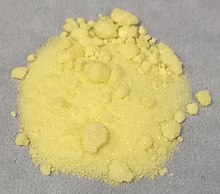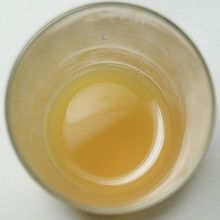 | |
| Names | |
|---|---|
| Other names
Holmium(III) acetate
| |
| Identifiers | |
| |
3D model (JSmol)
|
|
| ChemSpider | |
| ECHA InfoCard | 100.042.773 |
| EC Number |
|
PubChem CID
|
|
CompTox Dashboard (EPA)
|
|
| |
| |
| Properties | |
| Ho(CH3COO)3 | |
| Appearance | crystals |
| soluble | |
| Related compounds | |
Other anions
|
Holmium oxide Holmium hydroxide |
Other cations
|
Dysprosium acetate Erbium acetate |
Except where otherwise noted, data are given for materials in their standard state (at 25 °C [77 °F], 100 kPa).
| |

Holmium acetate is the acetate salt of holmium, with a chemical formula of Ho(CH3COO)3[1] as well as at least one hydrate.
Preparation
[edit]Holmium acetate can be obtained by dissolving holmium oxide in hot acetic acid[2]
- Ho2O3 + 6 CH3CO2H → 2 Ho(O2CH3)3 + 3 H2O
Dissolving holmium oxide in acetic acid at a pH of 4 will form the tetrahydrate of holmium acetate (Ho2(CH3COO)6·4H2O):[3] The anhydrous material can be obtained by heating the hydrated acetate in acetic acid.[1]
Physical properties and structure
[edit]Holmium acetate hemihepthydate decomposes at 105 °C, forming into a hemihydrate, further decomposing at 135 °C into an anhydride. Further adding heat will form Ho(OH)(CH3COO)2, HoO(CH3COO) then Ho2O2CO3, forming holmium oxide at 590 °C.[4]
According to X-ray crystallography, anhydrous holmium acetate is a coordination polymer. Each Ho(III) center is nine-coordinate, with two bidentate acetate ligands and the remaining sites occupied by oxygens provided by bridging acetate ligands. The lanthanum and praseodymium compounds are isostructural.[1] In a second polymorph, holmium acetate has 8-coordination.[2] A tetrahydrate has also been crystallized.[5]
Applications
[edit]Holmium acetate is used in the manufacture of ceramics, glass, phosphors, metal halide lamps, and as a dopant in garnet lasers. It is also used in nuclear reactors to keep the chain reaction in check.[6]
References
[edit]- ^ a b c Lossin, Adalbert; Meyer, Gerd (1994). "Pr(CH3COO)3, ein wasserfreies Selten-Erd-Acetat mit Netzwerkstruktur". Zeitschrift für Anorganische und Allgemeine Chemie. 620 (3): 438–443. doi:10.1002/zaac.19946200306.
- ^ a b Lossin, Adalbert; Meyer, Gerd (1993). "Wasserfreie Selten-Erd-Acetate, M(CH3COO)3 (M = Sm-Lu, Y) mit Kettenstruktur. Kristallstrukturen von Lu(CH3COO)3 und Ho(CH3COO)3". Zeitschrift für Anorganische und Allgemeine Chemie. 619 (9): 1609–1615. doi:10.1002/zaac.19936190917.
- ^ Anna Mondry, Krystyna Bukietyńska (1991-08-01). "Spectral intensities of holmium acetate single crystals". Inorganica Chimica Acta. 186 (1): 135–138. doi:10.1016/S0020-1693(00)87943-8. ISSN 0020-1693.
- ^ G. A. M. Hussein, B. A. A. Balboul, G. A. H. Mekhemer (2000-11-01). "Holmium oxide from holmium acetate, formation and characterization: thermoanalytical studies". Journal of Analytical and Applied Pyrolysis. 56 (2): 263–272. Bibcode:2000JAAP...56..263H. doi:10.1016/S0165-2370(00)00100-5. ISSN 0165-2370.
{{cite journal}}: CS1 maint: multiple names: authors list (link) - ^ Bats, J. W.; Kalus, R.; Fuess, H. (1979). "Holmium triacetate tetrahydrate". Acta Crystallographica Section B Structural Crystallography and Crystal Chemistry. 35 (5): 1225–1227. Bibcode:1979AcCrB..35.1225B. doi:10.1107/S0567740879005987.
- ^ "Holmium acetate". Retrieved 2014-01-01.
External reading
[edit]- R. S. Kolat, J. E. Powell (1962-05-01). "Acetate Complexes of the Rare Earth and Several Transition Metal Ions". Inorganic Chemistry. 1 (2): 293–296. doi:10.1021/ic50002a019. ISSN 0020-1669.